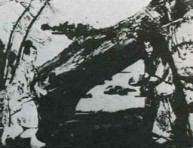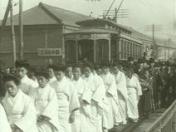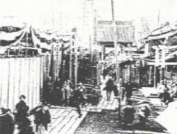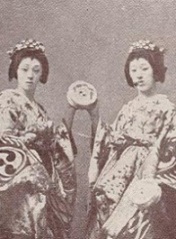28 November
|
Pioneer Japanese cinematographer Tsunekichi Shibata films three scenes from the kakubi play MOMIJIGARI (Viewing of Scarlet Maple Leaves), originated in Noh drama, featuring the kabuki actors Danjuro Ichikawa IX and Kikugoro Onoe V in the roles of princess Sharashina, in fact an ogre, and the famous warrior Komemori of the Taira clan. MOMIJIGARI was written by Mokuami Kawatake and premiered at Tokyo's Shintomi-za theatre in 1887 becoming a favorite within the kabuki repertoire by 1899. From 1 October that year the play was being performed at Tokyo's Kakubi-za. After its closing day performance on the 25, the theatre's manager Takejiro Inoue suggested to document a staging of the play in the garden of the tea house Bairin, situated behind the Kabuki-za. According to historian Junichiro Tanaka, Shibata informed him years later that the shooting had taken place on 28 November. However, Yoshinobu Tsukada, a historian completely neglected by Western research of the Japanese cinema of this period, as quoted in Manabu Ueda's Nihon Eiga Sosoki no Kogyo to Kankyaku: Tokyo to Kyoto o Chushin ni (p.191), proposes 30 November as an alternative date for the filming of MOMIJIGARI.
The print, however, had to wait until 1903 to be publicly released due to Ichikawa's extreme dislike of motion pictures. A private screening had been held earlier on 7 November 1900 at Ichikawa's residence. In July 1903, due to illness, Ichikawa had to cancel his performance in Osaka. Instead, he agreed for the film shot four years earlier to be shown. Yoshizawa Shoten initially organized a screening which also included NININ DOJOJI (Two people at Dojo Temple, Tsunekichi Shibata) at the Naka-za theatre from 7 to 15 July, although the show became so popular that it ran until 1 August. Ichikawa died on 13 September that year. Manabu Ueda quotes Denkikan's, first permanent film theatre in Japan which was operated by Yoshizawa Shoten, manager Matsunosuke Taniuchi as saying that a copy of the original print of MOMIJIGARI, owned by the advertising agency Hiromeya, was made without permission. It is believed that this unauthorized copy was the one exhibited at Naka-za theatre (Ueda, 192).
MOMIJIGARI's original print is thought to have been destroyed during the Great Kanto Earthquake of 1923. The existing print held by National Film Center in Tokyo was reassembled by the Nikkatsu film studio in 1927 from excerpts found in Shizuoka and Osaka. In 2006 Nikkatsu donated this edited version to the NFC. Its length of 6 minutes is close to the original version. The NFC also holds another copy, a 4 minutes version, donated by Shochiku's chairman Nobuyoshi Otani. Some sources such as the Bunka Isan Online (Cultural Heritage Online) hosted by the Agency of Cultural Affairs gives it a running time of 3 minutes and 50 seconds played at 16 frames per second and a footage length of 104.5 metres (342 feet and 13 frames)
MOMIJIGARI is considered to be the oldest surviving Japanese film, though not the oldest print, and, as Keiko I. McDonald points out, it was the first experiment of a engeki jissha eiga (films of ongoing stage action). Perhaps for this reason, on 10 July 2009, MOMIJIGARI became the first film to be designated by the Bunka Shinki-kai (Council for Cultural Affairs) as Juyo-Bunkazai (Important Cultural Property), sadly, as Aaron Gerow laments, "less because it was a film than because it, again, was a record of two illustrious actors". Gerow adds "The actual recommendation to the Minister of Education in fact categorized the film not as a film but as a "historical document" (rekishi shiryo)". This also seems to have the criteria put forward by the Council for the election of the two following films as Important Cultural Properties, SHIGEKI NANKO KETSUBETSU (A Historical play; Farewell of Nanko, 1921) and KOBAYASHI TOMIJIRO SOGI (The Funeral of Tomijiro Kobayashi, 1910)
On 29 June 2010 SHIGEKI NANKO KETSUBETSU became the second "film" to be denominated as Important Cultural Property. Again, SHIGEKI NANKO KETSUBETSU is a film recorded document divided in two parts. The first (SESSHONOMIYA DENKA KATSUDO SHASHIN TENRANKAI GOTAIRAN JIKKYO [The Prince Regent's Visit to the Motion Picture Exhibition, 3 minutes]) shows Prince Hirohito, later to become Emperor Showa, visiting on 8 December 1921 the first government-produced exhibition on cinema in Japan (20 October - 10 December 1921) held at now Tokyo National Museum within the premises of the Yushima Seido (Yushima Sacred Hall). The second part (SHIGEKI NANKO KETSUBETSU) follows briefly the prince to an open-air performance by Matsunosuke Onoe's troupe. The larger part of the footage records the staging of the scene in which Lord Kusunoki Masashige, played by Onoe, bids farewell to his son at Sakurai.
On 27 June 2011, a third film, KOBAYASHI TOMIJIRO SOGI (The Funeral of Tomijiro Kobayashi, 1910), was selected as Important Cultural Property, once more a documentary, this time chronicling the funeral of Tomijiro Kobayashi (1852-1910), founder of the Lion Corporation (formerly Kobayashi Shoten). As with SHIGEKI NANKO KETSUBETSU, its most significant value does not lie on any artistic quality of the film itself, but on its importance as a visual historical document of the funeral, attended by thousands of people, of a relevant figure of the Japanese society at the beginning of the 20th century. The film's negative that has survived to our days is thought to the original used during the shooting and, therefore, it is the oldest one known to exist in Japan. There is also a high probability that the negative of SHIGEKI NANKO KETSUBETSU, donated by Nikkatsu to the National Film Center in 2006, is the original negative filmed on 8 December 1921. If that is so, this negative film is the second oldest among existing Japanese film material.
Sources:
Keiko I. McDonald, Keiko, Japanese Classical Theater in Films, Fairleigh Dickinson University Press, 1994), p. 38.
Junichiro Tanaka, Nihon Eiga Hattatsushi, Vol.1, Chuo Koronsha, Tokyo, 1968, p. 70-74.
Aaron Gerow, Film as an Important Cultural Property in Tangemania: Aaron Gerow's Japanese Film Page, published on-line Mar 25, 2009.
Bunka Isan Online (Cultural Heritage Online), Eiga Firumu [MOMIJIGARI].
Bunka Isan Online (Cultural Heritage Online), Eiga Firumu [NANKO KETSUBETSU].
Daisuke Miyao, The Aesthetics of Shadow: Lighting and Japanese Cinema, Duke University Press Books, 2013, pp. 50-51.
Tomonori Saiki, SHIGEKI NANKO KETSUBETSU in La luce dell´Oriente: cinema giapponese muto, 1898-1935 / Light from the East: Japanese Silent Cinema, 1898-1935, 20th Pordenone Silent Film Festival, Sacile, 13-20 October 2001.
Eric Cazdyn, The Flash of Capital: Film and Geopolitics in Japan, Duke University Press, 2002, pp 15-18 and 264.
Fumiko Tsuneishi, KOBAYASHI TOMIJIRO SOGI in Light from the East: Celebrating Japanese Cinema Shochiku 110 - Naruse 100 -- Prog. 4, 24th Pordenone Silent Film Festival, Sacile, 8-15 October 2005.
Fumiaki Itakura, [Shigeki Nanko Ketsubetsu] (1921 nen) Kanensei Nega Firumu o Dotei Suru / Identifying the Nitrate Negative Film of Shigeki Nanko Ketsubetsu (1921), Tokyo Kokuritsu Kindai Bijutsukan Kenkyu Kiyo / Bulletin of the National Museum of Modern Art, Tokyo (14), 2010, 45-55.
Manabu Ueda, Nihon Eiga Sosoki no Kogyo to Kankyaku: Tokyo to Kyoto o Chushin ni, Waseda Daigaku Shuppanbu, 2012, pp. 172, 189 and 191-2.
|
 MOMIJIGARI
MOMIJIGARI
(Tsunekichi Shibata, 1899)
 KOBAYASHI TOMIJIRO SOGI
KOBAYASHI TOMIJIRO SOGI
(1910)
 SHIGEKI NANKO KETSUBETSU
SHIGEKI NANKO KETSUBETSU
(1921)
|




